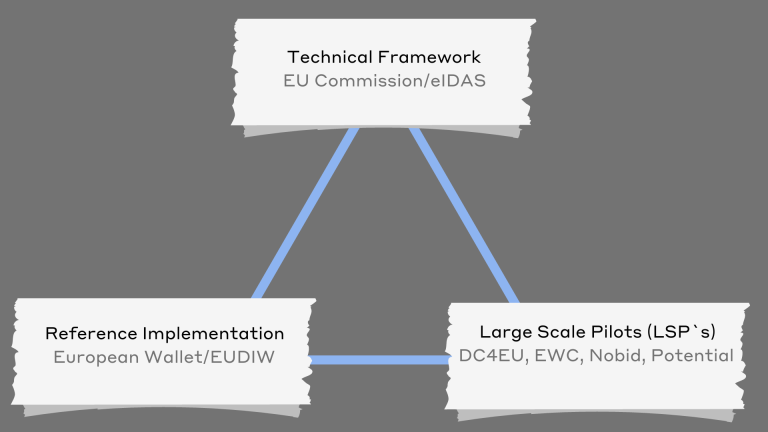Four large scale pilots have been initiated under the EU’s Digital Europe research and innovation programme: The European Wallet Consortium (EWC), DC4EU, Potential and Nobid. Their aim is to test the EU DigitalWallet (EUDIW) and the other components in the eIDAS 2.0 ecosystem and pilot them in practical application across Europe. On this subject the IDunion communications team conducted an interview with Steffen Schwalm, Principal Consultant | Senior Manager Digital Identity & Trust, msg.
What is the role of the Large Scale Pilots?
Their role can be illustrated quite well as a triangular structure: on one side of the triangle is the EU Commission, which is responsible for the regulation, and the eIDAS toolbox, which is used by the EU member states for establishing the technical framework of the EU digital wallet.
Below that we have the reference implementation for the European Wallet, and finally at the other end of the triangle we have the Large Scale Pilots (LSPs).
The idea behind this is to not just adopt regulations and standards where any malfunctions only become apparent during the implementation phase, but to combine regulations and technical specifications with immediate practical implementation.
This is precisely what the LSPs are all about: to provide direct feedback to all regulatory processes with concrete practical results, and to test all technical specifications in practical applications in order to find out what works and what does not. All this is happening in close cooperation with the EU Commission, the eIDAS toolbox and the reference implementation in order to create valid regulatory and technical foundations.
For example, issuing personal identification is not clearly described in the EU Architecture and Reference Framework ARF. Let us assume that there are five different opinions on this across four LSPs, so this is a clear indication to specify this more precisely.
So on the one hand we have a reference implementation that takes on specifications and explores their feasibility, and on the other hand we have the LSPs, which in turn examine the reference implementation in various use cases to check what practically works or needs to be adapted.
So it is much more than just establishing the rules and regulations plus a few technical standards, it is testing everything in time and creating practicality, thus avoiding any mistakes that were made with eIDAS 1.0.
Are all LSPs similar and do they have the same structure?
Yes, there is the basic rule for all of them that a LSP is always formally led by one or more EU member states. The companies are affiliated to them.
EWC is led by Sweden and Finland, DC4EU by Spain, Potential by France and Germany and for Nobid it is Norway and the Baltic States. The duration of all LSPs is two years – the start was on April 1, 2023.
Which of the four LSPs have the biggest opportunities?
All four LSPs have different focuses, so they are not directly comparable with each other. Also, I do not want to give an evaluation because our company msg is involved in the EWC. In any case, Potential is very strongly focused on non-DLT and deals with a wide range of use cases, from bank account opening to e-prescription to e-government. DC4EU focuses on diploma and social security passport. Nobid focuses purely on non-DLT and payment. EWC’s activities are focusing on organisational ID, payment transactions and use cases in the area of travel, while taking a dual approach, i.e. non-DLT and DLT.
That said, no consortium is more important than the other, they rather need each other.
This brings us to our next question: to what extent do you think the Commission sees room for other DLT-based solutions besides EBSI, such as Hyperledger-Indy or Aries.
This is a good question given the current situation, in light of the fact that the ARF is actually technology-agnostic. On the other hand, the EU is explicitly funding an EBSI project to develop Digital Wallet solutions based on the European Blockchain Service Infrastructure. Since each consortium has to establish interoperability with the other consortia in order to enable mutual cooperation as intended by the EU Commission – all of them definitely have to establish interoperability between DLT and legacy (non-DLT) solutions. The focus of DLT is certainly on EBSI, due to existing EU funding and goals.
What is the motivation of the multitude of companies involved within the four LSPs, because given the large number, the funding amount for each individual organisation is rather small.
Whoever is now participating in the LSPs, even if only as an associated partner, is directly involved in the development of the European digital identity for the next ten to fifteen years. And if eIDAS 2.0 remains as it is currently planned, it makes great sense for both the technology providers and the relying parties to participate. At the end of the day, all companies involved in critical infrastructure services will have to adopt this solution, as well as the whole banking and healthcare sector, as well as the GAFA. Which means a major part of the industry. All companies involved in the LSPs can help shape the technology from the beginning, steer it in the right direction and develop their own business models from it.
In what way is IDunion represented in the EWC consortium?
IDunion is indirectly involved in the EWC through the participation of many consortium partners and associated partners.
Thank you very much for the interview, Steffen.
You’re very welcome!
The interview was conducted by Benjamin Burde and Kordula Kiefer-Kempf from esatus AG.
